7 VIRAL INFECTIOUS DISEASES
Adenovirus/Epidemic Keratoconjunctivitis
Marcus G. Piccolo and Victor Malinovsky
ICD-9: 077.1—EPIDEMIC KERATOCONJUNCTIVITIS
ICD-9: 077.3—ADENOVIRAL KERATOCONJUNCTIVITIS
 THE DISEASE
THE DISEASE
Pathophysiology
Epidemic keratoconjunctivitis (EKC) is a common adenovirus disease that causes infection and subsequent inflammatory responses in the ocular adnexa, conjunctiva, and cornea. Adenoviruses are nonenveloped, double-stranded DNA viruses—seven species (A to G) and 54 serotypes have been identified. These viruses incorporate within host cells and use host cell organelles for replication. However, it appears that it is the protein coating surrounding the virus that is most inflammatory in the eye, and not the viral DNA or viral replication. These viruses can be easily transmitted and are resilient to standard disinfection techniques.
Etiology
EKC is the most serious form of ocular adenoviral infections and is most commonly caused by adenovirus species D, types 8 and 19, and less frequently by type 37; however, multiple serotypes are capable of producing a similar clinical presentation. EKC can be transmitted by close personal contact, as well as by contaminated surfaces and ophthalmic instruments. The incubation period is typically 5 to 10 days following inoculation of the conjunctiva. Because of the low natural immunity against these viruses, the general population is at significant risk for infection.
The Patient
Clinical Symptoms
The patient experiences marked foreign body sensation, photophobia, burning, and profuse tearing. Enlargement and tenderness of the ipsilateral preauricular lymph node are present in approximately one third to one half of adenovirus cases. Visual acuity is usually not affected in the early stages of the disease; however, acuity may decrease if and when the cornea becomes involved.
Clinical Signs
- Conjunctiva—Acute onset of redness and edema of the lids, plica, caruncle, and conjunctiva occurs over a 24- to 48-hour period (Fig. 7-1). Approximately 5 days after initial onset, follicles develop on the palpebral conjunctiva, occurring more noticeably inferiorly. Pseudomembranes may be present in as many as one third of the cases, which can make visualization of the follicles difficult. On occasion, a papillary conjunctivitis or subconjunctival hemorrhages may obscure the follicles as well. Initial presentation is usually unilateral with the second eye becoming less severely involved after 5 to 10 days. The conjunctival findings are usually self-limiting in 2 to 4 weeks; however, the patient remains infectious during this time. In rare cases, conjunctival scarring and symblepharon may occur.
- Cornea—A diffuse, fine, superficial keratitis, which stains with both fluorescein and rose bengal, may occur 2 to 3 days after the onset of symptom (Figs. 7-2 and 7-3). Seven to ten days later, an epithelial keratitis develops in approximately 30% to 50% of patients with grayish, focal, epithelial lesions that may stain with fluorescein. These lesions are the result of active viral infection and may persist for 1 to 2 weeks. Approximately 11 to 15 days after initial onset, gray subepithelial opacities begin to occur under the epithelial lesions. These opacities are an immune reaction to the viral antigen. In time, these lesions resolve, leaving characteristic subepithelial infiltrates. The subepithelial infiltrates may persist for weeks to months, and central lesions may cause decreased visual acuity and glare symptoms. In severe cases, epithelial sloughing and/or an accompanying anterior uveitis may occur.
- Eyelids—The eyelids may become significantly edematous, and blepharospasm may be present.
- Cornea—A diffuse, fine, superficial keratitis, which stains with both fluorescein and rose bengal, may occur 2 to 3 days after the onset of symptom (Figs. 7-2 and 7-3). Seven to ten days later, an epithelial keratitis develops in approximately 30% to 50% of patients with grayish, focal, epithelial lesions that may stain with fluorescein. These lesions are the result of active viral infection and may persist for 1 to 2 weeks. Approximately 11 to 15 days after initial onset, gray subepithelial opacities begin to occur under the epithelial lesions. These opacities are an immune reaction to the viral antigen. In time, these lesions resolve, leaving characteristic subepithelial infiltrates. The subepithelial infiltrates may persist for weeks to months, and central lesions may cause decreased visual acuity and glare symptoms. In severe cases, epithelial sloughing and/or an accompanying anterior uveitis may occur.
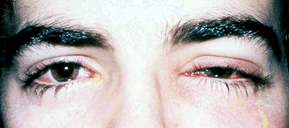
Figure 7-1. Epidemic keratoconjunctivitis. Note the bilateral but asymmetric presentation.
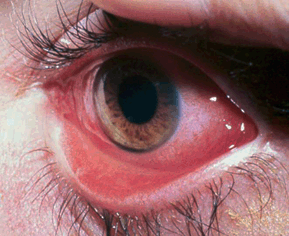
Figure 7-2. Early EKC. Note the chemotic bulbar conjunctiva.
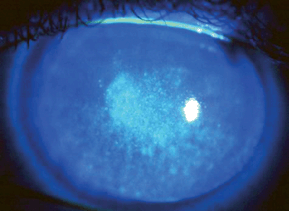
Figure 7-3. Early EKC. Note the diffuse corneal staining. Subepithelial infiltration will often develop later.
The course of the disease is usually of about 1 month’ duration. The patient is considered infectious for 2 weeks after initial onset.
Demographics
Adenoviruses account for 65% to 90% of all cases of viral conjunctivitis.
EKC usually occurs in young adults, ages 20 to 40 years, but children and the aged may also become infected.
Significant History
A history of association with other individuals with acute onset of red eyes is significant. Associated systemic findings such as an upper respiratory tract infection or fever are possible, but less common with EKC than with other viral eye diseases.
EKC is most common in the fall and winter months.
Laboratory confirmation of adenovirus is usually not necessary but can be made via a number of methods, including immunofluorescent techniques, immunoperoxidase techniques, serum titers to virus antibodies, polymerase chain reaction (PCR), enzyme immune assay, and direct inoculation to animal and human cell cultures. These techniques are infrequently needed and are seldom used clinically. If in-office diagnostic confirmation is desired, the RPS Adeno Detector is a commercially available product that tests for adenovirus antigen found in the external ocular environment. The test is readily available, takes about 10 minutes, and is noninvasive (www.rpsdetectors.com).
Cytology
Giemsa staining typically yields lymphocytes in the absence of a pseudo or true membrane. If a membrane is present, polymorphonuclear leukocytes (PMNs) may predominate. Eosinophilic intranuclear inclusion bodies may be present early, with basophilic intranuclear inclusion bodies appearing late.
Transmission
The virus can survive on nonporous surfaces (i.e., tonometer tips, countertops, magazine covers) for up to 34 days. It was initially named “shipyard disease” because of its epidemic occurrence within populations living in close proximity (first described in shipyards and military compounds). Adenovirus is commonly spread by hand-to-eye contact or from contaminated ophthalmic instruments that come into contact with the eye. Because of the contagious nature of this disease, a 2-week quarantine should be imposed on infected health care workers or other personnel who have contact with the public. Clinicians should be careful to disinfect any instrumentation that comes into contact with the patient. Care should be taken to avoid spread of the disease via vectors such as tissues, towels, or pillows. Frequent hand washing is mandatory.
The Treatment
There are no known cures for adenoviral infections; thus, treatment is aimed at prevention and support. Patients should be advised that their condition may worsen before it improves.
Cool compresses and artificial tears may help in alleviating symptoms, as may the application of topical vasoconstrictors (i.e., naphazoline drops four to six times per day). Topical antiviral agents have historically not been effective or useful for EKC. However, ganciclovir ophthalmic gel 0.15% (Zirgan, Sirion Therapeutics) has demonstrated activity against adenovirus. Small studies have shown that ganciclovir-treated patients showed significantly shorter mean time to recovery versus controls.
The use of corticosteroid drops is controversial, as steroids only mask the symptoms of the infection and may promote viral replication and prolong viral shedding. It may, however, be appropriate to use medium-potency (FML Forte, Flarex, Lotemax) or high-potency (prednisolone acetate 1%) corticosteroid drops to quiet the initial inflammatory response during the first 2 weeks, which are then rapidly tapered. Steroid use may be especially helpful in the presence of conjunctival membranes. Rarely, steroid therapy may be reinstituted at a later date for treatment of severe subepithelial opacification (prolonged or severe symptoms, significant visual loss), but steroid use may also prolong the duration of the disease. In addition, steroids can produce unwanted side effects (i.e., corneal immunosuppression, intraocular pressure [IOP] elevations, and cataracts), and tapering is often difficult as a result of inflammatory rebound.
Pharyngoconjunctival Fever
Marcus G. Piccolo and Victor Malinovsky
ICD-9: 077.2
 THE DISEASE
THE DISEASE
Pathophysiology
Pharyngoconjunctival fever (PCF) is an infection and subsequent inflammatory response in the conjunctiva and cornea to several serotypes of adenovirus. The disease usually presents unilaterally, but the fellow eye is ultimately involved in approximately 50% of cases. The disease is highly communicable.
Etiology
PCF is most commonly caused by adenovirus serotypes 3, 4, and 7 and less commonly by types 1, 5, 6, and 14. However, all serotypes of adenovirus are capable of producing PCF in rare instances.
The Patient
Clinical Symptoms
Acute presentation of a unilateral red eye with associated pharyngitis and fever is the hallmark of PCF. Foreign body sensation, burning, mild photophobia, lid swelling, and a watery or scant mucoid discharge may occur. The disease typically manifests 5 to 10 days after inoculation. Visual acuity is usually unaffected unless the cornea is significantly involved. In addition to the ocular findings, the patient may experience malaise, myalgia, headache, abdominal discomfort, or diarrhea.
Clinical Signs
- Lids, conjunctiva, and adnexa—The tarsal conjunctiva demonstrates a follicular reaction, more evident inferiorly. The bulbar conjunctiva becomes inflamed and chemotic and may demonstrate some hemorrhagic changes. Conjunctival membranes and pseudomembranes can occasionally occur, and the superior and inferior lids are usually edematous. A small ipsilateral, nontender, preauricular lymph node is typically palpable; less frequently, a nontender submandibular lymph node is noted.
- Cornea—The cornea occasionally exhibits a mild, superficial punctate keratitis (SPK) early in the disease. Six to eight days after the initial symptoms, a focal epithelial keratitis may occur. This focal keratitis may lead to subepithelial infiltrates, which manifest 1 to 2 weeks after the onset of the conjunctivitis. The infiltrates are typically smaller and less severe than the classic subepithelial infiltrates associated with an adenoviral EKC. In general, the cornea has a less severe presentation in PCF compared to EKC.
The infection is self-limiting, with complete resolution without sequelae in 3 to 4 weeks. The virus can be found in ocular tissue for up to 2 weeks after onset. However, the virus can be isolated in the feces for up to 30 days.
Although any age can be affected, PCF tends to occur more frequently in children and may become epidemic in schools as a result of the highly contagious nature of the virus. For this reason, infected children should be quarantined for at least 2 weeks or until no fever or ocular discharge is present.
Transmission often occurs via droplets, or it may be water borne via hot tubs or swimming pools. Intrafamilial transmission is not uncommon. Chlorination of pools does not significantly inhibit the virus. Fecal contamination of swimming pools may be responsible for outbreaks.
Significant History
Association with children or other individuals with an acute onset of red eyes is significant. History of swimming in contaminated pools could be important.
Ancillary Tests
Confirmation of adenovirus can be made via a number of methods, including immunofluorescent techniques, immunoperoxidase techniques, serum titers to virus antibodies, and direct inoculation to animal and human cell cultures. These techniques are seldom required and infrequently used.
Cytology
Giemsa staining typically yields lymphocytes in the absence of a pseudo- or true membrane. If a membrane is present, PMNs may predominate. Eosinophilic intranuclear inclusion bodies may be present early, with basophilic intranuclear inclusion bodies appearing late.
The Treatment
Treatment of PCF relies on supportive measures and isolation of affected individuals. Cool compresses, artificial tears, and vasoconstrictors (e.g., naphazoline drops four to six times per day) may be of some value. The disease is self-limiting in approximately 21 days with no ocular sequelae anticipated; therefore, drugs such as corticosteroids are usually not necessary.
Prevention of disease relies on prompt diagnosis, quarantine of affected individuals, and frequent hand washing. In addition, use of separate hand towels, pillows, eating utensils, and washcloths by infected patients is important.
Acute Hemorrhagic Conjunctivitis
Marcus G. Piccolo and Victor Malinovsky
ICD-9: 077.4
 THE DISEASE
THE DISEASE
Pathophysiology
Acute hemorrhagic conjunctivitis (AHC) is a viral infection and subsequent inflammation of the conjunctiva, cornea, and lids. The acute and rapid inflammatory response causes petechial or subconjunctival hemorrhages giving the descriptive name to the disease. In addition to conjunctival secretions, transmission of the virus by respiratory and oral routes accounts for the rapid and extensive spread of the disease during an outbreak.
Etiology
AHC is caused by inoculation of the conjunctiva with enterovirus 70 (EV-70) or coxsackie virus A24 (CA-24). The infection is most commonly the result of hand-to-eye contamination or contact with fomites. The disease is extremely contagious and has occurred in epidemic or pandemic proportions in dense population centers. Epidemics of AHC have been documented since 1969 when it was first seen in Ghana and given the name “Apollo II” conjunctivitis (this was during the U.S. Apollo space missions). It was later more descriptively named AHC. The incubation period for AHC is very short, consisting of 1 to 2 days with a rapid onset of signs and symptoms. Resolution usually occurs within 7 to 14 days after onset.
The Patient
Clinical Symptoms
Symptoms of AHC include sudden onset of a unilateral, painful conjunctivitis, which rapidly becomes bilateral. The patient will likely experience epiphora, photophobia, marked lid swelling, itching, ocular irritation, and/or periorbital pain. Systemically, the patient may experience flu-like symptoms of myalgia, malaise, headache, and pharyngitis.
Clinical Signs
Patients characteristically show a follicular reaction of the inferior conjunctiva. Although this disease is typically bilateral, one eye is usually more involved than the other. The patient will show eyelid edema, conjunctival chemosis, and a profuse mucoid discharge. Small, palpable, nontender, preauricular lymphadenopathy is often noted.
The “hallmark” sign is the presence of subconjunctival hemorrhages. The hemorrhages may be petechial or diffuse but are more commonly confluent, especially late in the presentation. Early in the disease, hemorrhages under the superior bulbar conjunctiva may show a pattern of concentric semilunar patterns following the arch of the limbus (Fig. 7-4). Hemorrhage may also be present in the upper palpebral conjunctiva. Some patients may have a unilateral or bilateral ecchymosis (Fig. 7-5).
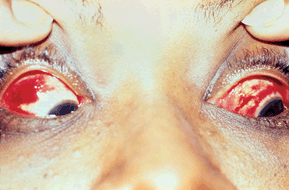
Figure 7-4. Acute hemorrhagic conjunctivitis. Notice the concentric subconjunctival hemorrhages in the superior portion of the left eye.
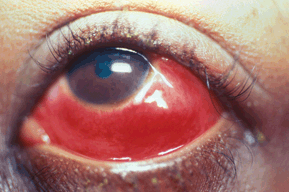
Figure 7-5. Acute hemorrhagic conjunctivitis. Notice the chemotic bulbar conjunctiva.
The cornea may show a fine punctate epithelial keratitis with mild subepithelial infiltrates similar to an adenoviral infection.
Rarely, the patient may experience paralysis of the lower extremities (Guillain–Barre’ syndrome), as well as a transient Bell’ palsy.
Demographics
AHC affects men and women equally, and all age groups are susceptible with highest predilection for those in the early teenage years. The disease tends to be epidemic and affects populations that are living in very close quarters without proper hygiene.
Significant History
An association with others who have a similar ocular presentation is significant because of the very contagious nature of AHC.
Diagnosis is usually made on a clinical basis; however, viral isolation is highest during the first week of the infection.
Conjunctival scrapings typically yield the presence of lymphocytes in the smear.
The Treatment
Treatment for AHC is largely supportive since the disease is self-limiting with very rare ocular sequelae. The use of analgesics, ocular astringents, cool compresses, and lubricants may make the patient more comfortable during the acute phases of the disease.
Since the disease is highly contagious, the patient should be quarantined for 7 to 10 days following the onset of symptoms.
Topical corticosteroids have not demonstrated a significant advantage because of the typically short course of the disease. Exceptions might include membrane or psuedomembrane formation or the development of subepithelial corneal infiltrates overlying the visual axis. However, steroids may predispose the patient to a corneal superinfection, thus increasing the risk of microbial keratitis. The use of corticosteroids should always be evaluated related to their relative risks and benefits.
Patients should be educated on proper hygiene including using their own hand towels, face towels, and pillowcases. The patient should limit touching of his or her eyes, and hand washing should be performed frequently.
On occasion, secondary bacterial infections may arise. The presence of a purulent discharge may signal a secondary bacterial infection. These infections should be treated with appropriate antibiotics; however, the use of antibiotics to treat AHC without the development of a secondary bacterial infection is not necessary and should be avoided.
Herpes Simplex Virus: Ocular Manifestations
Nicky R. Holdeman
ICD-9: 054.40
 THE DISEASE
THE DISEASE
Pathophysiology
Herpes simplex virus (HSV) is a ubiquitous DNA virus that affects the majority of the population by a very young age. Transmission of the virus occurs by direct contact with infected lesions, by salivary droplets, by fomites, and by healthy, asymptomatic carriers. Incubation period, between contact and disease, is 3 to 9 days.
While the primary infection may be mild or subclinical in nature, the virus may reactivate and ultimately involve various ocular structures. Potential manifestations include blepharitis, conjunctivitis, corneal epithelial disease, stromal disease, neurotrophic (metaherpetic) ulceration, endotheliitis, trabeculitis, uveitis, and/or retinitis. Active viral replication, pathogenicity of the virus, and host immune responses are major factors of recurrent ocular herpes.
Etiology
There are two types of HSV that affect humans, HSV-1 and HSV-2. HSV-1 commonly causes labialis and ocular manifestations and is transferred by direct contact with cold sores, saliva, or fomites. HSV-2 is usually genital in nature and is typically acquired by sexual contact or may be transferred to an infant during birth. The initial HSV-1 infection may involve the face, mouth, eye, or nose and is often obscure, with the virus becoming dormant in the trigeminal ganglion or remaining latent in the skin or cornea. HSV-2 is harbored in the sacral ganglion.
Note: It was once held that recurrent eruptions were triggered by physical or emotional stress, febrile illnesses, fatigue, trauma, exposure to ultraviolet (UV) rays, contact lens wear, surgery, steroids, menstruation, and/or certain foods. However, the association and significance of these factors have not been well documented.
The Patient
Clinical Symptoms
The principal symptoms are foreign body sensation, burning, stinging, skin rash, photophobia, pain, lacrimation, conjunctival hyperemia, and reduced acuity. HSV is often in the differential diagnosis of any inflammatory eye disease of the anterior segment that has an unclear etiology.
Unilateral disease is present in well over 90% of the patients; thus, bilateral HSV disease should increase suspicion of systemic immune depression.
Clinical Signs
Presentation is varied and may be similar to many other ocular disorders. Physical findings will vary depending on the structures involved. Each of the following conditions can potentially occur (see Table 7-1).
TABLE 7-1 Ocular Manifestations of HSV
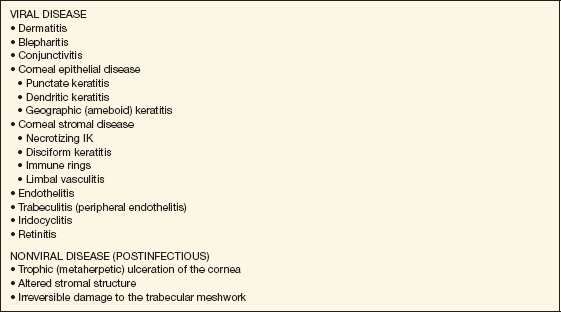
- Dermatitis/blepharitis—clear lid vesicles, atop an erythematous base, may appear on the upper or lower lids or on the lid margin. May be present in primary or recurrent disease, but recurrent episodes are more commonly associated with other eye findings than the primary infection. Lid swelling is usually present, but visual acuity is unaffected.
- Conjunctivitis—typically produces diffuse conjunctival injection, watery discharge, follicles, and tender preauricular lymph node enlargement. Pseudomembranes may be seen in more severe infections and could lead to conjunctival scarring, loss of goblet cells, and a permanent dry eye condition. May occur in primary disease or in recurrent infections, with or without eyelid vesicles or epithelial keratitis.
- Corneal epithelial infections—caused by live HSV replication. Lesions may manifest as a SPK, corneal vesicles a classic single, branching dendrite with club shaped terminal end bulbs (Fig. 7-6), marginal ulcers or geographic ulceration. Corneal sensitivity is often reduced in the involved eye.
- About 11% of patients with an epithelial ulceration will ultimately develop stromal disease.
- Corneal stromal disease—there are several presentations of stromal disease caused by HSV; three are mentioned below. Stromal keratitis is a less common, but a more sight threatening form of herpetic disease.
1. Necrotizing interstitial keratitis (IK)—deep inflammation throughout the cornea, often associated with uveitis, synechia, elevated IOP, thinning, and neovascularization. In severe cases with dense infiltrates, there may be extensive necrosis and a hypopyon, mimicking the appearance of a bacterial keratitis. Massive immune response; antigen-antibody-complement mediated, with rapid viral replication.
2. Disciform keratitis (Fig. 7-7)—focal disc-shaped area of stromal edema, without necrosis or corneal neovascularization; usually associated with an intact epithelium. Severe cases may show diffuse edema, folds in Descemet’ membrane, fine KP, iritis, and thinning of the stroma. Probably, a cell-mediated (lymphocyte), delayed hypersensitivity reaction.
3. Altered stromal structure (i.e., old disciform scar)—repeated bouts of stromal inflammation may result in endothelial dysfunction resulting in a permanently vascularized, scarred, and/or edematous cornea.
- Neurotrophic (metaherpetic) keratopathy—occasionally, recurrent or protracted episodes of herpetic keratitis will cause corneal hypoesthesia, abnormal tear film stability, and structural damage to the basement membrane, resulting in a sterile ulceration of the cornea. Persistence of trophic ulceration may lead to stromal melting and subsequent perforation. Other etiologic factors include drug toxicity and decreased tear formation.
- Endotheliitis—rarely, HSV may result in endothelial cell swelling, pleomorphism, and decompensation with secondary stromal edema. Endothelial cell damage is believed to be an immune, inflammatory reaction, with likely viral replication in the endothelium as well.
- Trabeculitis—inflammation, edema, and obstruction of the trabecular meshwork may result in transient or permanent glaucoma. Inflammation may occur with or without active corneal disease.
- Uveitis—a nongranulomatous iridocyclitis, usually associated with corneal disease but can occur as an isolated finding. This condition is felt to result from an immune inflammatory reaction but may also have a live virus component.
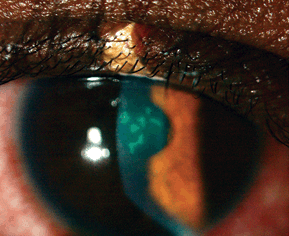
Figure 7-6. Herpes simplex epithelial keratitis stained with NaFl.
Stay updated, free articles. Join our Telegram channel

Full access? Get Clinical Tree


